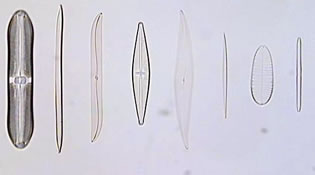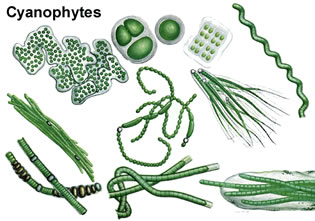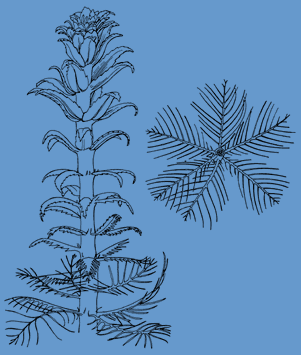 |
 |
WATER QUALITY AND YOUR LAKE
![]()
- Why does a lake become green and stinky?
- What causes surface scum on a lake?
- Does foam on the shore of a lake mean it's polluted?
- Why does the water quality of our lake seem to get worse throughout the summer?
- What can I do to help improve the water quality of my favorite lake?
- Who can I contact if I have questions or a problem related to water quality?
- What are some additional resources related to water quality?
Why does a lake become green and stinky?
Pungent green lakes are usually blooming with algae. Algae are simple, small aquatic plants. An algal bloom is a dense concentration of these plants. Like grass and trees, algae use sunlight, carbon dioxide, and nutrients to generate energy and produce more algae. In most lakes, algal growth is limited by the availability of the nutrients, nitrogen (N) and phosphorus (P).
Eutrophication is the term used to describe the process of nutrient enrichment leading to excessive plant growth and the subsequent sedimentation of dead and rotting vegetation to the lake bottom. This natural process is often accelerated by human activities in the watershed, which introduce unnaturally high quantities of nutrients into lakes. Two common bloom-forming algae are diatoms and blue-green algae. Diatom blooms usually occur in the late spring or early summer, turning the water a bright green or brown but not causing surface scums or odors. Blue-green algal blooms create greater problems for lake users. The most obnoxious forms are buoyant during the day and can form thick surface scums, especially on a calm sunny afternoon. This scum may be blown into shallow water making the shoreline appear as though it has been slicked with blue-green paint.
When algae die the bacteria that break them down use up oxygen in the water. If enough algae die at one time, decomposition may use up the oxygen faster than wind mixing or photosynthesis can replenish it. This can lead to anoxic (no oxygen) conditions and the build-up of hydrogen sulfide gas (rotten egg smell) or ammonia in deep water. Certain species of algae can also be toxic to domestic animals.
What causes surface scum on a lake?
There are various causes of surface scums on a lake or pond. Look more closely to determine what is on the water’s surface. An oily film or yellow-green dust on the surface of a lake make it look contaminated but, in most cases, nothing is wrong. In fact, something natural is probably occurring. An oily film in mid-summer may be caused by organic compounds from nearby wetlands, rotting vegetation, or insect cases that were concentrated along the shore by wind after a hatch. Insects can hatch at any time from ice-out in the spring until mid-September. As the insect cases decompose, they sometimes produce an oily film. Yellow-green dust floating on the surface in late spring and early summer is probably pollen from nearby trees. In contrast, a scum from an algal bloom is green to blue-green, might have an oily sheen that resembles a motor oil slick, and can form a thick, soupy mass on the surface of the water.
Does foam on the shore of a lake mean it's polluted?
The foam found in lakes and streams is usually natural. Wind-driven currents frequently create parallel streaks of foam in open water that accumulate along windward shores and in coves. Foam is created as decomposing plants and animals release organic compounds into the water. The compounds reduce the surface tension of water, causing bubbles to form. Many people blame shoreline foam on detergents, but detergents don’t create long-lasting foam since they quickly lose their sudsing ability. Industrial pollution effluents may have been a more common source of foam on surface water in the past, but these days point source discharges are more closely regulated through the National Pollutant Discharge Elimination System (NPDES) permits.
Why does the water quality of our lake seem to get worse throughout the summer?
Lakes change a great deal over the course of a year. Changes are caused by seasonal weather patterns, watershed influences, and the life cycles of the lake’s biota. During the winter, ice and snow severely limit the amount of light available for photosynthesis under the ice, so there is not much algal growth. In the spring, snowmelt washes nutrients into the lake. Many of the nutrients are used by rapidly growing aquatic plants (macrophytes) near the shoreline, resulting in a "clear water" phase.
As macrophyte growth slows in mid- to late-summer, incoming nutrients and nutrients from decomposing aquatic plants become available for algae. Available nutrients, combined with warm water and plentiful sunlight, can result in a period of heavy algal growth, potentially making the lake green and scummy. Mid-summer water quality problems may be particularly acute if you live on a shallow lake where high winds can mix warm surface water all the way down to the lake’s bottom waters. When this happens, nutrients are released from the mud and sediments up into the surface water where light is plentiful and algae can flourish. In autumn, the combination of decreased daylight, cooler temperatures, and more zooplankton grazing on algae, reduces algal growth and yields clearer water once again.
Myriophyllum heterophyllum
Variable-leaf milfoilWhat can I do to help improve the water quality of my favorite lake?
You can improve your favorite lake’s water quality by becoming educated and involved. You and your neighbors can monitor the lake to learn why and how the water quality has changed and identify ways to minimize impacts. For instance, if erosion and excess nutrients are degrading water quality, follow the proven techniques for stabilizing shores suggested in Protecting Our Waters: Best Management Practices for Protecting Your Shoreline. Protecting Your Shoreline explains how to minimize nutrient inputs, reduce human impacts, restore shorelines, and monitor lakes. Several additional resources are listed below.
Who can I contact if I have questions or a problem related to water quality?
Check your local telephone listing, the “Who to Contact” section of the Minnesota Shoreland Management Resource Guide Web site, www.shorelandmanagement.org, or the Web sites listed below for:
- Your county Water Plan Coordinator
- Your county Soil and Water Conservation District (SWCD) (www.maswcd.org)
- Minnesota Department of Natural Resources regional hydrologists (MDNR) (www.dnr.state.mn.us)
- Minnesota Pollution Control Agency (MPCA) (www.pca.state.mn.us)
- Minnesota Lakes Association (MLA) (www.mnlakes.org)
- North American Lake Management Society (NALMS) (www.nalms.org)
What are some additional resources related to water quality?
- A Primer on Limnology. 1992. B.A. Monson. University of Minnesota Water Resources Center
- Minnesota Lake and Watershed Data Collection Manual. 1994. Minnesota Pollution Control Agency
- LakeSmarts: The First Lake Maintenance Handbook. 1993. S. McComas. Terrene Institute
- A Citizens’ Guide to Lake Protection. Freshwater Foundation and the MPCA
- A Guide for Buying & Managing Shoreland. 1988. Minnesota Department of Natural Resources, Division of Waters
- Lake and Reservoir Restoration Guidance Manual. 1990. North American Lake Management Society
- Protecting Our Waters, Shoreland Best Management Practices. 1998. University of Minnesota Extension Service
- Sustainable Lake Management Handbook. 2000. Minnesota Lakes Association


